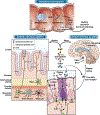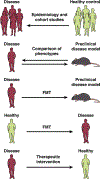The Microbiota-Gut-Brain Axis: From Motility to Mood
- PMID: 33493503
- PMCID: PMC8634751
- DOI: 10.1053/j.gastro.2020.10.066
The Microbiota-Gut-Brain Axis: From Motility to Mood
Abstract
The gut-brain axis plays an important role in maintaining homeostasis. Many intrinsic and extrinsic factors influence signaling along this axis, modulating the function of both the enteric and central nervous systems. More recently the role of the microbiome as an important factor in modulating gut-brain signaling has emerged and the concept of a microbiota-gut-brain axis has been established. In this review, we highlight the role of this axis in modulating enteric and central nervous system function and how this may impact disorders such as irritable bowel syndrome and disorders of mood and affect. We examine the overlapping biological constructs that underpin these disorders with a special emphasis on the neurotransmitter serotonin, which plays a key role in both the gastrointestinal tract and in the brain. Overall, it is clear that although animal studies have shown much promise, more progress is necessary before these findings can be translated for diagnostic and therapeutic benefit in patient populations.
Keywords: Brain Gut Axis; Irritable Bowel Syndrome; Microbiota-Gut-Brain Axis; Mood Disorders; Motility.
Copyright © 2021 AGA Institute. Published by Elsevier Inc. All rights reserved.
Figures



References
-
- Drossman DA. Functional Gastrointestinal Disorders: History, Pathophysiology, Clinical Features and Rome IV. Gastroenterology 2016. - PubMed
Publication types
MeSH terms
Grants and funding
LinkOut - more resources
Full Text Sources
Other Literature Sources
Medical

